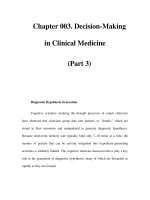Chapter 064. The Practice of Genetics in Clinical Medicine (Part 5) pptx
Bạn đang xem bản rút gọn của tài liệu. Xem và tải ngay bản đầy đủ của tài liệu tại đây (64.14 KB, 6 trang )
Chapter 064. The Practice of Genetics
in Clinical Medicine
(Part 5)
Molecular analysis is generally more informative if testing is initiated in a
symptomatic family member, since the identification of a mutation can direct the
testing of other at-risk family members (whether they are symptomatic or not). In
the absence of additional familial or environmental risk factors, individuals who
test negative for the mutation found in the affected family member can be
informed that they are at general population risk for that particular disease.
Furthermore, they can be reassured that they are not at risk for passing on the
mutation to their children. On the other hand, asymptomatic family members who
test positive for the known mutation must be informed that they are at increased
risk for disease development and for transmitting the alteration to their children.
Clinicians providing pretest counseling and education should assess the
patient's ability to cope with test results. Individuals who demonstrate signs and
symptoms of emotional distress should have their psychosocial needs addressed
before proceeding with molecular testing. Generally, genetic testing should not be
offered at a time of personal crisis or acute illness within the family. Patients will
derive more benefit from test results if they are emotionally able to comprehend
and absorb the information. It is important to assess patients' preconceived notions
of their personal likelihood of disease in preparing pretest educational strategies.
Often, patients harbor unwarranted fear or denial of their likelihood of genetic
risk.
Genetic testing has the potential of affecting the way individual family
members relate to one another, both negatively and positively. As a result, patients
addressing the option of molecular testing must consider how test results might
impact their relationships with relatives, partners, spouses, and friends. In families
with a known genetic mutation, those who test positive must consider the impact
of their carrier status on their present and future lifestyles; those who test negative
may manifest survivor guilt. Family members are likely to differ in their emotional
and social responses to the same information. Counseling should also address the
potential consequences of test results on relationships with a spouse or child.
Parents who are found to have a disease-associated mutation often express
considerable anxiety and despair as they address the issue of risk to their children.
When a condition does not manifest until adulthood, clinicians will be
faced with the question of whether at-risk children should be offered molecular
testing and, if so, at what age. Although the matter is debated, several professional
organizations have cautioned that genetic testing for adult-onset disorders should
not be offered to children. Many of these conditions are not preventable;
consequently, such information can pose significant psychosocial risk to the child.
In addition, there is concern that testing during childhood violates a child's right to
make an informed decision regarding testing upon reaching adulthood. On the
other hand, testing should be offered in childhood for disorders that may manifest
early in life, especially when management options are available. For example,
children at risk for familial adenomatous polyposis (FAP), associated with
alterations in the APC gene, may develop polyps as early as their teens, and
progression to an invasive cancer can occur by their twenties. Likewise, children
at risk for MEN type 2, which is caused by mutations in the RET proto-oncogene,
may develop medullary thyroid cancer early in childhood, and the issue of
prophylactic thyroidectomy should be addressed with the parents of children with
documented mutations (Chap. 345).
Informed Consent
When the issue of testing is addressed, patients should be strongly
encouraged to involve other relatives in the decision-making process, as molecular
diagnostics will likely have an impact on the entire family. Informed consent for
molecular testing begins with detailed education and counseling (Fig. 64-3). The
patient must fully understand the risks, benefits, and limitations of undergoing the
analysis. Informed consent should include a written document, drafted clearly and
concisely in a language and format that is comprehensible to the patient, who
should be made aware of the disposition of test results. Informed consent should
also include a discussion of the mechanics of testing. Most molecular testing for
hereditary disease involves DNA-based analysis of peripheral blood. In the
majority of circumstances, test results should be given only to the individual, in
person, and with a support person in the room.
Figure 64-3
Because molecular testing of an asymptomatic individual often allows
prediction of future risk, the patient should understand any potential long-term
medical, psychological, and social implications of this decision. In the United
States, legislation affecting this area is still evolving, and it is important to explore
with the patient the potential impact that test results may have on employment and
future health, as well as disability and life insurance coverage.
Patients should understand that alternatives to molecular analysis remain
available if they decide not to proceed with this option. They should also be
notified that testing is available in the future if they are not currently prepared to
undergo analysis. The option of DNA banking should be presented so that samples
are readily available for future use by family members, if needed.









